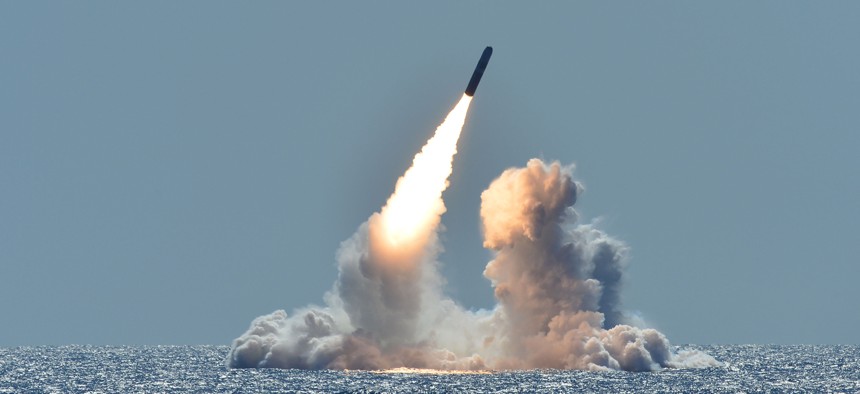
An unarmed Trident II D5 missile launches from the Ohio-class ballistic missile submarine USS Nebraska off the coast of California. Mass Communication Specialist 1st Class Ronald Gutridge
A New Nuclear Warhead? STRATCOM Chief Can’t Answer Yes or No
The W93 has been the focus of questions since it appeared in the 2021 budget proposal.
Is the United States developing an all-new nuclear weapon for its missile submarines? The new commander of U.S. Strategic Command had a variety of answers when asked about the W93 warhead by lawmakers on Thursday, but none of them were yes or no.
“It was a new program of record,” Adm. Charles Richard, who leads U.S. Strategic Command, responded to Rep. John Garamendi, D-California, who asked about the W93 at a House Armed Services Committee hearing. But Richard declined several times to say whether the W93 is a new weapon. “It hasn’t been designed yet, sir,” Richard told Garamendi. “We have to ask first to start the program before we can answer some of these questions.”
When Rep. Mike Turner, R-Ohio, asked about it, Richard responded: “The W93, I think, that it's one of those things that makes me proud to be an American” because it addresses what he described as a strategic imbalance in the U.S. military arsenal against Russia.
The questions began to swirl earlier this month, after Hans Kristensen, who directs the Nuclear Information Project at the Federation of American Scientists, noticed something new in the Energy Department’s 2021 budget proposal. A line item requested funds for a “concept assessment” of the W93, a warhead for the Navy’s submarine-launched Trident D5 missiles.
The “new designation indicates something…significant. I guess the Pentagon is now allowed to make ‘new’ warheads again,” Kristensen tweeted on Feb. 10.
On Friday, a senior defense official who demanded anonymity offered some explanation to reporters at the Pentagon. They said the W93 would replace the W76 and the W88, the two warheads that currently top Trident missiles.
“Both of these systems are growing old,” the official said. “Now, we must start thinking about a warhead that will replace one of those two when it's time for those systems to retire. These things take a long time [and] there's a seven-phase process by which we start to develop a warhead.”
The official said the W93 would be “previously nuclear-tested designs, it's not going to require any nuclear testing” and that it would not increase the size of the nuclear stockpile.
But as Kristensen noted, the brand-new designation of “W93” indicates a new design. Richard’s comments Thursday shed no new light on the mystery.
Richard also took a moment to offer a preview of the sort of advice he would give about the New START Treaty, which is due to expire next year. The treaty caps the number of strategic nuclear weapons that the United States and Russia can hold and allows both sides to inspect and verify each other's stockpile.
“I support any arms control agreement that enhances the security of this nation,” Richard said. He acknowledged that Russia has “largely been compliant with it.”
But the STRATCOM chief said that New START does not address “new weapon systems not covered by the treaty that are also threats to us”: the Avangard hypersonic missile, the Poseidon nuclear torpedo, and potentially others. “My best military advice would be, I would like to have all of that. That would make my job the easiest,” he said.
As for America’s own arsenal, Richard warned that the “nation is at a critical juncture regarding the future of our nuclear forces.” If the U.S. military’s nuclear weapons and the submarines, bombers and ICBMs are not replaced soon, the existing “triad” could age out.
“If we do not invest smartly in our nuclear enterprise now, we may begin to reach points of no return,” Richard said. “And I predict they'll start in the nuclear weapons complex, next in the nuclear command and control, and finally in the triad delivery systems. It may result in our need to rebuild nearly from scratch over one or more decades our enterprise talent and infrastructure required to be a nuclear power.”
Modernizing the military’s nuclear arsenal is Pentagon leaders’ top priority. Defense officials often point out that the efforts to design and build these new submarines, bombers and ICBMs — as well as a new nuclear-armed cruise missile — were all started during the Obama administration.
“The choice isn't between allowing the arsenal to waste away or funding every sustainment and modernization program the Trump administration is proposing. That's a false choice,” said Kingston Reif, director of disarmament and threat reduction policy at the Arms Control Association.
“The question is whether the administration's approach is necessary, sustainable, and safe, especially in the absence of any negotiated restraints on the U.S. and Russian nuclear arsenals,” Reif said. “The answer is that the administration's current course is unnecessary, unsustainable, and unsafe — and must be rethought.”



